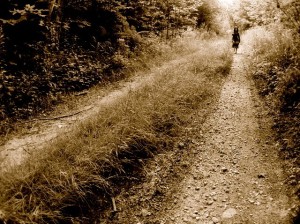Elliot Wolfson’s Reading Time (Part 4)
By Asher Crispe: July 20, 2012: Category Inspirations, Thought Figures
Enter Merleau-Ponty
 Unquestionably, amongst the greatest voices of 20th century continental philosophy, Maurice Merleau-Ponty, weighs in as an important counterpoint to Heidegger. Wolfson, in his critique of linear time and the dictatorship of philology, moves beyond Heidegger and modern science as preliminary arguments over to Merleau-Ponty as the point man for the final assault. For Wolfson, it is in Merleau-Ponty that he finds refuge as he asserts that:
Unquestionably, amongst the greatest voices of 20th century continental philosophy, Maurice Merleau-Ponty, weighs in as an important counterpoint to Heidegger. Wolfson, in his critique of linear time and the dictatorship of philology, moves beyond Heidegger and modern science as preliminary arguments over to Merleau-Ponty as the point man for the final assault. For Wolfson, it is in Merleau-Ponty that he finds refuge as he asserts that:
…in his thought I find an affinity with the understanding I have derived from the study of kabbalistic literature and consequently feel it is legitimate to use his jargon to formulate hermeneutical and phenomenological suppositions in reading these sources. (15)
Particular to Wolfson’s project is the desire to harvest Merleau-Ponty’s notion of time reversibility. This would further justify the use of contemporary theory and philosophy to elucidate literature that is often separated by centuries. As we have already seen, the ability—if not the necessity—to bring the present upon the past (my time of telling), emerges alongside of the unavoidable force of the past brought to bear on the present (the telling of time). Wolfson contends:
As a way into the topic in Merleau-Ponty’s writings, we might say that the phenomenon of time reversibility, for him, is contemplated from within the frame of the reversibility of seeing/being seen, that is a doubling of vision—the inherent reflexivity of the perceptual—that maintains identity of difference in difference of identity. (16)
This reflexivity of the perceptual works its way into the reflexivity of the textual by way of one of Wolfson’s trademark inversions—the A-B-B-A form of “identity of difference in difference in identity.” As with many of these constructions, this one has the effect of interrupting the tranquil flow of thought. I’m jolted. Once roused to my senses, I perceive in the fold of this expression the double mirror of truth whose reflections display the essential interinclusion of ideas.
Snatched from its pedestal, the principle of identity as A=A or A is A, implies a kind of temporal idealism. The self-sameness that identity implies either requires a synchronous comparison where one object meets the terms of A=A and not A=B in the instant of analysis, or else, as an equally plausible alternative, plucks the object from the stream of time (if time can be conceived as a stream) evoking a state of exception. Formal logical identity places the object beyond the law of temporality for otherwise there would be no such thing as consistency, prediction and recognition.
What then does it mean to “maintain the identity of difference in the difference of identity”? The identity of difference would presumably be the expression of A not equaling B. This expression itself must remain constant. By contrast, the “difference of identity” would seem to imply a comparison between two identities A=A and/verses B=B. This is true however if we read Wolfson’s statement with the following interpolation: ‘the difference of identity’ between two things. If we assume he means ‘the difference of identity’ within the same thing then we have the story of oneself as another or the revised formula A=B.
On account of the first part of the assertion ‘the identity of difference’ added to the second part of A=B the strange idea emerges that this occurs even as A=A. In other words, we have to see ‘oneself as another’ even as we perceive ‘oneself as oneself’ or in the remarkable words of Paul Celan “I am you if I am I.” (17) This marks not a personal identity crisis but rather the crisis of the principle of identity. The reevaluation of the principle of identity may, in the final analysis help to explain and alleviate many cases of identity crisis. This goes for history, that is, identity of historical objects, as well as, psychology. Such a critique will allow for the settling of accounts between the conceptual deficits between continuity and change, sameness and difference.
Transposed into the terms of temporality, the synchrony of the ‘identity of difference’ encounters the diachrony of the ‘difference of identity.’ Normally, in philology we only partake of the linear model that serves the ‘identity of difference’ while neglecting the non-linear quality of the diachronic ‘difference of identity.’ This problem for Wolfson unfolds in:
The philologists privileging of historical proximity in determining lexicography is predicated on the assumption regarding the linear character of time—just as the cartographer assumes a linear grid in charting spatial dimensions even though scientific evidence indicates that the geometric character of space is cylindrical. (18)
 Yet the solution implied in “maintaining the identity of difference in the difference of identity” cannot be viewed as a simple opposition of diachrony to synchrony. Chief concerns include allowing the other to be other—particularly through temporal alterity—while I remain myself and notwithstanding I have to be the other in some form of limited transcendence while continuing to remain myself.
Yet the solution implied in “maintaining the identity of difference in the difference of identity” cannot be viewed as a simple opposition of diachrony to synchrony. Chief concerns include allowing the other to be other—particularly through temporal alterity—while I remain myself and notwithstanding I have to be the other in some form of limited transcendence while continuing to remain myself.
Wolfson points out that Merleau-Ponty casts the terms in a relationship where “…we are to conceive synchrony and diachrony as enveloping rather than opposing one another.” (19) Not to suggest that this ‘enveloping’ will produce a complete understanding, for the limits of perception apply to both the observer of historical proximity and the patron of non-linear comparativism well stocked with contemporary theory. Despite the elaborate staging under this new pavilion, Wolfson acknowledges that “to articulate a synchronic-diachronic whole within speech—that would surely constitute “monumental,” even “mythical,” speech, as Merleau-Ponty suggests. Attaining such a whole, however, is not possible from a perceptual standpoint.” (20) This position is further qualified:
Time is continuously in the making; hence at no time can time be circumscribed in a self-enclosed body; the “objective-world” is a product of human construction, an orderly and effective edifice, to be sure, but one that can always be destabilized by the chiasmic texture of time’s interruptive flow—the temporality of the event instantiates the event of temporality in the disruption of familiar patterns that are remembered and/or anticipated. (21)
15 Language, Eros, Being. p. xxi.
16 Ibid. p. xxi.
17 Selected Poems and Prose of Paul Celan. From “Praise of Distance” p. 24.
18 Language, Eros, Being. p. xvi-xvii.
19 Ibid. p. xxii.
20 Ibid. p. xxii.
21 Ibid. p. xxvii.
http://www.interinclusion.org/inspirations/elliot-wolfsons-reading-time-part-5/























;)
;)
;)
;)
;)
;)
;)
;)
;)
;)
